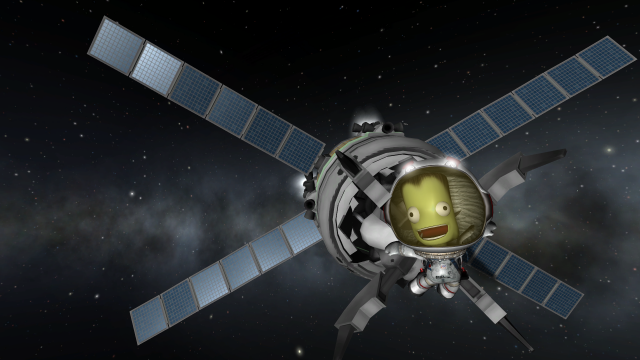General Discussion
Related: Editorials & Other Articles, Issue Forums, Alliance Forums, Region ForumsNASA admits there's 'a chance' that asteroid 2013 TX68 COULD smash into Earth
http://www.mirror.co.uk/tech/nasa-admits-theres-a-chance-7448889NASA has dramatically changed its mind about the risks posed by asteroid 2013 TX68 , a 100ft-wide rock which is currently heading towards Earth.
It said there was "a chance" it could plough into our planet next year when it makes another flyby.
However, we are glad to report that NASA thinks the odds of a collision on September 28, 2017, are "no more than 1-in-250-million".
It's like winning the powerball
SoLeftIAmRight
(4,883 posts)Given the choice I would rather win the powerball
lovuian
(19,362 posts)long shot
ThoughtCriminal
(14,047 posts)get both.
awoke_in_2003
(34,582 posts)RKP5637
(67,111 posts)underahedgerow
(1,232 posts)Get those roughnecks ready to blast that thing with a nuclear warhead!
Brother Buzz
(36,448 posts)underahedgerow
(1,232 posts)motherfucker".
That's my movie sorted for this evening!
Brother Buzz
(36,448 posts)one nuclear weapon and a thing that has 270,000 moving parts built by the lowest bidder. Makes you feel good, doesn't it?

I caught it on Netflix just last week.
A HERETIC I AM
(24,371 posts)(At least I think it was Mercury) that was similar.
Something to the effect that he was sitting on top of a several hundred thousand pound bomb built by the lowest bidder on a government contract and the next nearest person was 3 miles away!
cherokeeprogressive
(24,853 posts)Mr. Irreverent. When they asked him to go first he said, "Yeah, I'll give it a shot."
Brother Buzz
(36,448 posts)Thank Goodness we have studs like Bruce Willis, Ben Affleck, Billy Bob Thornton, and Steve Buscemis to keep us safe.
dembotoz
(16,811 posts)Blue_In_AK
(46,436 posts)The first pass isn't the dangerous one, it's the second.
lovuian
(19,362 posts)Solly Mack
(90,776 posts)randome
(34,845 posts)[hr][font color="blue"][center]TECT in the name of the Representative approves of this post.[/center][/font][hr]
NickB79
(19,257 posts)Not mass extinction level punch, mind you, but still enough to starve a bunch of us to death through crop failures and weather alternations.
muriel_volestrangler
(101,331 posts)It might kill people close to it if it exploded/hit very near a populated area, but not 'crop failures and weather alterations', I think:
Scientists at NASA's Center for NEO Studies (CNEOS) at the Jet Propulsion Laboratory in Pasadena, California, have determined there is no possibility that this object could impact Earth during the flyby next month. But they have identified an extremely remote chance that this small asteroid could impact on Sep. 28, 2017, with odds of no more than 1-in-250-million. Flybys in 2046 and 2097 have an even lower probability of impact.
"The possibilities of collision on any of the three future flyby dates are far too small to be of any real concern," said Paul Chodas, manager of CNEOS. "I fully expect any future observations to reduce the probability even more."
Asteroid 2013 TX68 is estimated to be about 100 feet (30 meters) in diameter. By comparison, the asteroid that broke up in the atmosphere over Chelyabinsk, Russia, three years ago was approximately 65 feet (20 meters) wide. If an asteroid the size of 2013 TX68 were to enter Earth's atmosphere, it would likely produce an air burst with about twice the energy of the Chelyabinsk event.
https://www.nasa.gov/feature/jpl/small-asteroid-to-pass-close-to-earth-march-5
NickB79
(19,257 posts)I was assuming a hard impact and subsequent ejecta pattern. It would depend on the composition of the asteroid.
Given that even a "small" nuclear war between India and Pakistan could result in a global nuclear winter and crop failures, and a 100-ft wide asteroid would be hitting with the force of many nukes at once, I feel my hypothesis is still plausible: http://www.livescience.com/44380-small-nuclear-war-could-trigger-catastrophic-cooling.html
muriel_volestrangler
(101,331 posts)https://en.wikipedia.org/wiki/Impact_event
In the Wikipedia table, a 98ft diameter asteroid has kinetic energy at atmospheric entry of 1.3MT. They don't calculate the impact energy for one that small (because it would still probably explode in the air, like Tunguska), but extrapolating from the larger ones they do do the calculation for, it would lose well over half its energy - in fact, the airburst would be more damaging (the calculations come from Imperial College, London - a sample one).
It's equivalent to one modest thermonuclear bomb - the kind of thing they tested many times without affecting weather, and that do hit Earth every few hundred years.
Ghost Dog
(16,881 posts)on the first pass, I suggest the probability that the quoted probability of a hit on the second pass is accurate is not very high.
![]()
muriel_volestrangler
(101,331 posts)The probability of a hit is correct. It is the probability of the asteroid hitting the Earth, in their models, given the fuzziness of the information they currently have. It's not that there will be a series of random events that could produce a hit.
Ghost Dog
(16,881 posts)Not a big one, anyway. I'd like to see a Richter-like scale for these events, rather than the megaton analogy.
muriel_volestrangler
(101,331 posts)The British tabloids got it wrong. On Feb 25th, NASA revised its calculation (because it got new observations) and changed their estimate of a hit in 2017 from 1 in 250 million (what they said on Feb 2nd) to zero (what they said Feb 25th). They also say that this March, it won't pass closer than 15,000 miles, when they had said 11,000 earlier.
See, for instance, a site that reports on space, and so reports things like this better than British tabloids (a Google news search shows that it's only the British tabloids, and a few web-only sites, that are still quoting the 1 in 250 million chance):
The observations, from archived images provided by the NASA-funded Pan-STARRS asteroid survey, enabled scientists at NASA's Center for Near-Earth Object Studies (CNEOS) at the Jet Propulsion Laboratory in Pasadena, California, to refine their earlier flyby and distance predictions, reconfirming that the asteroid poses no threat to Earth.
...
CNEOS's new prediction for 2013 TX68 is that it will fly by roughly 3 million miles (5 million kilometers) from our planet. There is still a chance that it could pass closer, but certainly no closer than 15,000 miles (24,000 kilometers) above Earth's surface.
The new observations also better constrain the path of 2013 TX68 in future years; CNEOS has determined that 2013 TX68 cannot impact Earth over the next century.
http://www.spacedaily.com/reports/Small_Asteroid_to_Pass_Close_to_Earth_March_8_999.html
But the thing about a probability is that you don't quote it with an uncertainty; any uncertainty just raises the improbability. Rather than saying "it's a 1 in a 1000 probability, plus or minus something", you say "it's a 1 in a 1,500 probability".
Nitram
(22,825 posts)...the odds are in our favor.
A HERETIC I AM
(24,371 posts)Shandris
(3,447 posts)The 23rd. Seems some kind of Revelations linky thing about constellations, verses, and the placement of the stars.
That'll be more than enough to get the End Timers fired up.
Warren DeMontague
(80,708 posts)In Kerbal Space Program.

Tommy_Carcetti
(43,185 posts)
Although, if we were nine months into a President Trump administration, I'd gladly welcome the prospect of worldwide species annihilation.
lunatica
(53,410 posts)And it would probably break up upon entry into our atmosphere so it would create damage, but nothing like the 10 kilometer wide one that killed off the dinosaurs.
Reter
(2,188 posts)Not a world changer anyway (but it can still do a lot of damage).
muriel_volestrangler
(101,331 posts)Here's the NASA page: https://www.nasa.gov/feature/jpl/small-asteroid-to-pass-close-to-earth-march-5
It's dated, at the top, Feb. 2, 2016. And it has, in normal font, this paragraph:
"During the upcoming March 5 flyby, asteroid 2013 TX68 could fly past Earth as far out as 9 million miles (14 million kilometers) or as close as 11,000 miles (17,000 kilometers). The variation in possible closest approach distances is due to the wide range of possible trajectories for this object, since it was tracked for only a short time after discovery.
Scientists at NASA's Center for NEO Studies (CNEOS) at the Jet Propulsion Laboratory in Pasadena, California, have determined there is no possibility that this object could impact Earth during the flyby next month. But they have identified an extremely remote chance that this small asteroid could impact on Sep. 28, 2017, with odds of no more than 1-in-250-million. Flybys in 2046 and 2097 have an even lower probability of impact."
But, above that, in bold type, it has:
Additional observations of asteroid 2013 TX68 have been obtained, refining its orbital path and moving the date of the asteroid’s Earth flyby from March 5 to March 8.
The observations, from archived images provided by the NASA-funded Pan-STARRS asteroid survey, enabled scientists at NASA's Center for Near-Earth Object Studies (CNEOS) at the Jet Propulsion Laboratory in Pasadena, California, to refine their earlier flyby and distance predictions, reconfirming that the asteroid poses no threat to Earth.
"We already knew this asteroid, 2013 TX68, would safely fly past Earth in early March, but this additional data allow us to get a better handle on its orbital path," said Paul Chodas, manager of CNEOS. "The data indicate that this small asteroid will probably pass much farther away from Earth than previously thought."
Marco Micheli of the European Space Agency's NEO Coordination Centre (NEOCC/SpaceDys) in Frascati, Italy, is the astronomer who identified the object in the archived images, measured its position, and provided these observations to the Minor Planet Center in Cambridge, Massachusetts.
CNEOS's new prediction for 2013 TX68 is that it will fly by roughly 3 million miles (5 million kilometers) from our planet. There is still a chance that it could pass closer, but certainly no closer than 15,000 miles (24,000 kilometers) above Earth's surface. The new observations also better constrain the path of 2013 TX68 in future years; CNEOS has determined that 2013 TX68 cannot impact Earth over the next century.
"There is no concern whatsoever regarding this asteroid – unless you were interested in seeing it with a telescope," said Chodas. "Prospects for observing this asteroid, which were not very good to begin with, are now even worse because the asteroid is likely to be farther away, and therefore dimmer than previously believed."
So the change of mind that NASA had was to go from a 1 in 250-million chance to no chance.